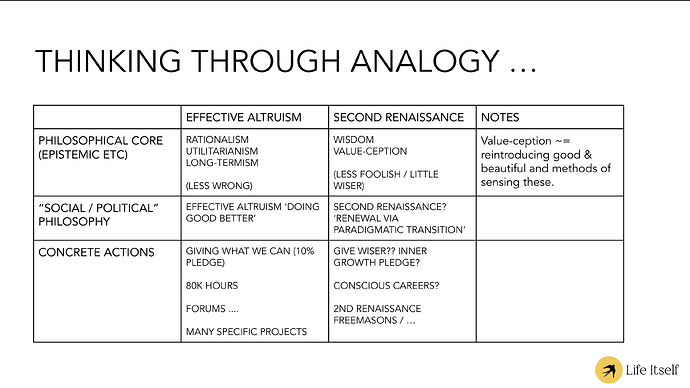The connections / learnings / extensions from effective altruism are of great interest to me personally and I think more generally to the community.
There’s a variety of existing material to share plus new dialogs to be had.
For now, to get things started i’m just x-posting some material from discord threads back in July 2024 mainly from a discussion with Quinn McHugh
Great to hear from you - thank-you for sharing.
BTW the connections / learnings / extensions from effective altruism are of great interest to me personally.
In particular, i’ve found it fruitful reflection to think of what are the analogies/parallels are to various EA endeavours in “this space”.
Analogy table
e.g. here is a slide from a recent-ish presentation [Life Itself Gathering in June 2024] (though we’ve discussed them for several years)
GiveWiser (vs GiveWell)
- As a specific thought experiment: what, if anything, would distinguish “give well” from “give wiser” etc …
Quinn had some great thoughts and suggestions
Interesting! Thanks for sharing, Rufus. A couple of thoughts (note: I’m making a lot of assumptions here about the nature of the second renaissance ecosystem, so I’d love to hear your thoughts on where I might be missing the mark):
- I’ve found it a bit strange how EA as a community has placed greater emphasis on longtermism in recent years and yet, I’ve seen comparatively little discourse on effective approaches to achieving systemic change (like those discussed by Ashoka or Systems Innovation). With this in mind, I would say that EA’s philosophical core is more linear in nature (do actions → achieve impact) whereas second renaissance is more networked in nature (foster conditions for impact to be generated → impact emerges)
- I think EA has suffered from its historically decentralized approach to social change in addition to the somewhat high degree of community insularity. In contrast, second renaissance seems to embrace the expansive nature of its network and places great emphasis on achieving long-term, collective impact, prioritizing network resilience, organizational health, and trust building.
Re the analogy table
- I’m having trouble understanding what “paradigmatic” means in the context of “paradigmatic transition” [Ans: paradigm is short for cultural paradigm or socio-cultural paradigm. e.g. modernity is a paradigm. Pre-modernity was a paradigm. This paper sets this out with a bit of detail Second Renaissance. So we are talking about a transition on the scale of pre-modern (e.g. medieval) to modern (e.g. liberte, egalite, fraternite) …
- “Give well” = Investing your resources to achieve the greatest immediate or short-term positive change within a capitalist frame. Focuses on research/evidence, efficiency, and return on investment.
- “Give wiser” = Investing your resources to contribute to transformative change. Takes a more holistic, long-term, and systemic lense.
Value of a more concrete theory of change
I feel as if the EA community might place more emphasis on ruthless pragmatism and persistent agency than second renaissance. While I do appreciate the expansive vision laid out by second renaissance, I think it may benefit from a more concrete theory of change and giving specific examples of how different people/organizations are applying a second renaissance way of looking at the world? (e.g. a society’s values are what ultimately shapes its outputs → to change our values, we need more inner growth/wisdom/interbeing → achieving more inner growth means educating our populous about themselves, the nature of our world, and our place in it → this could involve doing things like (X), or (Y), or (Z) → here’s some organizations that are actually pursuing that and how you might be able to do the same in your community/bioregion/little corner of the Earth)
[Ed: the second “How” second renaissance white paper goes some way to addressing this.]
